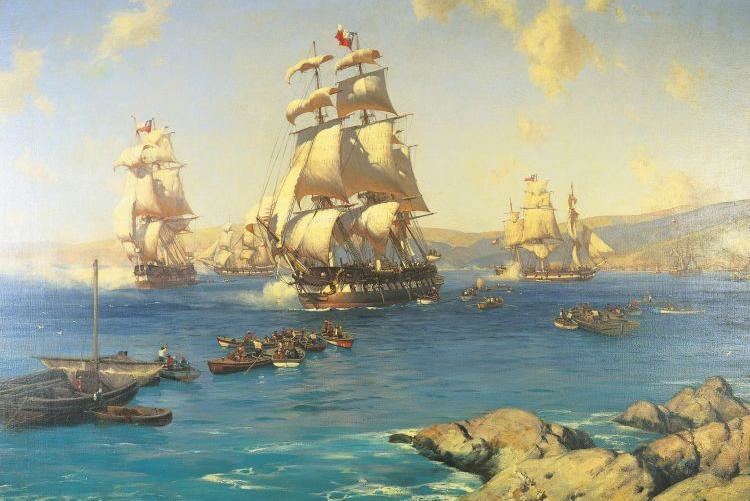None Unknown | ||
 | ||
The Expedición Libertadora del Perú (Liberating Expedition of Peru) was organized in 1820 by the government of Chile, with elements belonging to the Liberating Army of the Andes and to recently restored Army of Chile, whose target was to free the Viceroyalty of Perú from Spanish rule. The expedition was the continuation of the plan of liberation that General Bernardo O'Higgins and General José de San Martín conceived for the Spanish colonies of South America. While the Chilean government headed by Bernardo O'Higgins played a pivotal role in organizing the expedition, the control of the Chilean Squadron was given to Thomas Cochrane, 10th Earl of Dundonald and the control of the ground force relapsed into the Argentine General José de San Martín. The expedition managed to liberate parts of Peru.
Contents
Precedents
In 1814 the General Captaincy of Chile was reconquered by the Spanish Crown, in the Disaster of Rancagua, putting term to the period named Patria Vieja (Old Homeland), in which the Chilean patriots had governed the destinations of the colony and conceived notable reforms to the colonial Spanish diet. Later to above mentioned event, the Chilean troops, along with the personeros of the government, fled to Mendoza, where they were got by the governor of the province of Cuyo General José de San Martín, the one who conceived in that moment a plan of liberation of the South American colonies of the Spanish Empire. This plan would consist of invading Chile with an army shaped by the remains of the Army of Chile, defeated in Rancagua, and Argentine troops. After the invasion and liberation of Chile, for the allied army, this one would embark for sea course to Peru to extinguish the Spanish presence in that region, since he supposed a big threat for the independence of other Latin Americans countries.
The emancipation of Perú was to have been a common enterprise by Chile and Argentina. Argentina, then a loose alliance of provinces, distracted by internal strife and another threat of invasion from Spain, was unable to contribute for the expedition and ordered José de San Martín back to Argentina. San Martín choose to disobey (see Acta de Rancagua) and O'Higgins decided that Chile would assume the costs of the Freedom Expedition of Perú.
The Squadron
On 20 August 1820 the expedition sailed from Valparaíso for Paracas, near Pisco in Perú. The escort was provided by the squadron and comprised the flagship O'Higgins (under Captain Thomas Sackville Crosbie), frigate San Martín (Captain William Wilkinson), frigate Lautaro (Captain Martin Guise), the corvette Independencia (Captain Robert Forster), the brigs Galvarino (Captain John Tooker Spry), Araucano (Captain Thomas Carter), and Pueyrredón (Lieutenant William Prunier) and the schooner Moctezuma (Lieutenant George Young).
Every expeditionary ship got a painted number so that it could be identified at a distance. There are discrepancies between authors about the names and number and some names of the transports.
On 8. September 1820 the liberating army disembarked 100 miles southeast of Lima: 4118 soldiers, 4000 of them were Chileans.
On the night of 5. November Cochrane, personally, and 240 volunteers wearing white with blue armbands captured the Spanish frigate Esmeralda (1791) within the port of Callao. She was renamed Valdivia and commissioned to the Chilean Navy.
